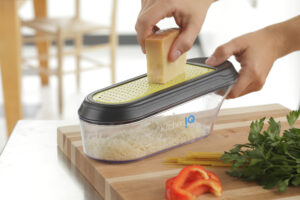How to Use a Grater: A Guide for Beginners
A grater is a simple but essential kitchen tool that can be used for a variety of tasks, from grating cheese to zesting citrus fruits. While it may seem straightforward, knowing how to use a grater properly can make a big difference in the outcome of your dishes. In this article, we will provide a comprehensive guide on how to use a grater, including the different types of graters, the proper techniques for grating, and tips for cleaning and maintenance.

Types of Graters
Before we dive into how to use a grater, it’s important to understand the different types available. Here are the most common types of graters:
Box Grater: This is the most traditional type of grater, and it features four sides with different sized holes for grating. The larger holes are typically used for grating cheese, while the smaller holes are used for finer grating, such as zest or ginger.
Microplane Grater: This type of grater has become increasingly popular in recent years for its ability to finely grate ingredients with precision. It features small, sharp teeth that are ideal for grating hard cheeses, ginger, garlic, and citrus fruits.
Rotary Grater: This type of grater uses a hand-crank mechanism to grate ingredients. It’s ideal for grating large quantities of cheese, and it typically comes with interchangeable drum blades for different grating sizes.

Proper Techniques for Grating
Now that you know the different types of graters, let’s dive into the proper techniques for grating. These techniques apply to all types of graters.
Choose the Right Side: If you’re using a box grater, choose the side with the hole size that’s appropriate for the ingredient you’re grating. For example, use the larger holes for grating cheese and the smaller holes for zesting citrus fruits.
Hold the Grater: Hold the grater firmly with one hand while holding the ingredient with the other hand. For larger ingredients, such as cheese blocks or fruits, it’s best to use a cutting board to hold the ingredient.
Grate with a Steady Motion: Start grating with a steady back-and-forth motion, applying gentle pressure. Be careful not to press too hard, which can cause the ingredient to break apart or the grater to slip.
Rotate the Ingredient: As you grate, rotate the ingredient to ensure even grating on all sides. This is especially important for hard cheeses, which can become misshapen if grated unevenly.
Watch Your Fingers: Be careful not to grate your fingers on the grater. Hold the ingredient firmly and keep your fingers away from the grating surface.
Tips for Cleaning and Maintenance
After using your grater, proper cleaning and maintenance is crucial to keep it in top condition. Here are some tips for cleaning and maintaining your grater:
- Rinse Immediately: Rinse the grater under hot water immediately after use to remove any food particles.
- Use a Brush: Use a soft-bristled brush to remove any food that is stuck in the teeth. Be sure to wash the brush thoroughly after each use.
- Avoid Harsh Detergents: Avoid using harsh detergents that can damage the grater. If necessary, use a mild dish soap and a soft sponge.
- Dry Thoroughly: Dry the grater thoroughly with a clean towel before storing it. Moisture can cause rust or corrosion over time.
- Store Properly: Store the grater in a dry place, away from moisture or humidity. You can also use a protective cover or sleeve to prevent accidental injury.
Conclusion
Using a grater may seem simple, but using the proper techniques and understanding the different types of graters can make a big difference in the outcome of your dishes. By following the tips outlined in this article, you can use your grater with confidence and keep it in top condition for years to come. Whether you’re grating cheese, zesting citrus fruits, or grating other ingredients, a grater is a versatile and essential tool in any kitchen.